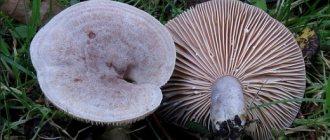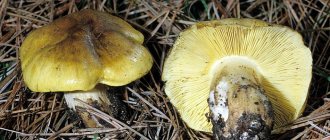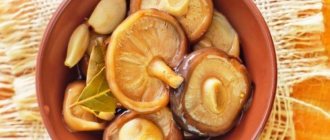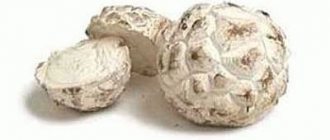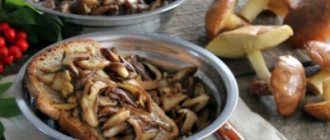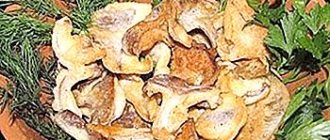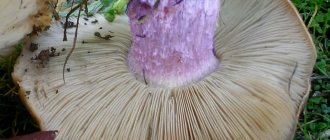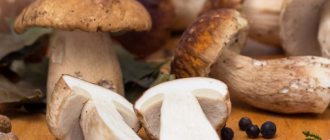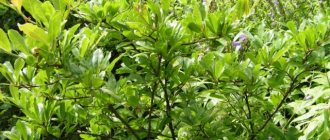Collecting and eating green mushrooms
Enjoying the harvest, lovers of “quiet hunting” will certainly take greenfinch mushrooms into their baskets. In winter and spring, they will perfectly decorate the table and are suitable for preparing salads and marinades.
The row has a dense fleshy cap of yellow, green or yellowish-olive color with a diameter of 4 to 12 cm.
Greenfinch (greenweed or golden rower) belongs to the rower family and belongs to the genus Lamelidae. The bulk of this species is conditionally edible; consumption is possible only after processing: pickling, fermentation, decoction. It lives in Russia in coniferous and mixed forests, on dry sandy soils. Sometimes they can be found in deciduous forests, under aspen trees, where they will be large in size.
The mushroom is collected at the end of August and until the beginning of November.
What mushrooms can be confused with - edible and poisonous?
Greenfinches are very popular in our forests and have many doubles, with which it is very important to differentiate them.
Serukhas and zelenukhas: how to distinguish
Greenfinches are often confused with silverbacks. Mushrooms have the following differences:
| Description | Zelenukha | Serukha | |
| Systematization | genus Tricholoma, family Oryadaceae | genus Mlechnik, family Russulaceae | |
| hat | form | flat-convex | funnel-shaped |
| the edges | smooth, sometimes slightly raised | uneven, wavy, curled down | |
| color | yellow-green | gray with pink or purple tint | |
| concentric circles | none | may meet | |
| Leg | color | yellow, yellow-green | pink-gray, gray-violet |
| peculiarities | brownish scales at the bottom | longitudinal grooves | |
| Smell of pulp | flour | fruit | |
| Records | frequent | rare | |
| Spore powder | white | yellowish | |
| milky juice | absent | white, caustic | |
Serushki always grow in the neighborhood. This factor also contributes to the fact that they are often brought in the same basket with greenfinches. It is not dangerous to confuse these mushrooms, since serukhs also belong to the conditionally edible category.
Row sulfur-yellow
This species is considered poisonous. Therefore, it is dangerous to mistake sulfur-yellow rows for greenbushes.
Mushrooms are confused due to their external similarity in color. The fruiting body of the row is also represented by shades of yellow, but without greenery. The place and time of mushroom fruiting, which coincides for these species, play a role.
You can distinguish the row by its bitter, bright yellow pulp, which emits a sharp and unpleasant odor. And in size it is significantly inferior to greenfinches.
Ryadovka burning
The fruiting bodies of spruce (or sultry, burning) rows also have greenish tints in their color. However, their predominant color is brown. Therefore, only an inexperienced mushroom picker can bring home a burning row instead of a greenfinch. The second similarity is the yellowness of the plates.
You can distinguish a row by the following characteristics:
- bell-shaped (in young mushrooms) or flat with a depression (in adult mushrooms) cap shape;
- relatively small size;
- high and thin leg;
- burning taste of pulp;
- unpleasant smell.
Remember!
Stinging row is considered an inedible type of mushroom.
Green russula
This species is considered conditionally edible. Its representatives, like greenfinches, are green in color. But in russula it is expressed in a darker shade.
You can identify green russula by the plates. They are colored cream and are located very densely.
Death cap
One of the most dangerous species is the pale grebe. This mushroom is very poisonous. Eating its fruits is accompanied by very serious consequences.
The caps of young mushrooms of this species are very similar to the caps of greenfinches. We can say that the toadstool repeats the shape and color of the caps of the latter. Therefore, it is quite easy to confuse them.
Distinctive features of the pale grebe are the following:
- white plates;
- presence of a ring on the stem.
Also, toadstools of this species are characterized by the presence of a volva - a filmy wrap around the stem of the mushroom.
Description of the golden row
The row has a dense fleshy cap of yellow, green or yellowish-olive color with a diameter of 4 to 12 cm. In young plants it is flat-convex with a tubercle on top, in mature plants it is spread out with raised, slightly wavy edges. Upon reaching adulthood, the cap darkens. The skin is thick, smooth to the touch, in rainy weather it becomes slimy and covered with soil particles and adherent leaves. This is due to the fact that the cap has small scales to which foreign bodies stick.
On the reverse side, the cap has frequent and thin plates 5-12 mm wide, lemon-yellow, sometimes greenish-yellow. When broken, the flesh is dense and white. The mushroom is less susceptible to infection than other brethren, and is practically never wormy. If you make a cut, the color on it does not change. When inhaled, the odor has a floury tint and an unexpressed taste. Experienced mushroom pickers note that the most pronounced smell is characteristic of rows that grew in a pine forest.
Greenfinch (greenfinch or golden rower) belongs to the rower family and belongs to the genus Lamelidae
If you pay attention to the leg, it is short and thickened towards the bottom, completely hidden in the ground. The color is yellow or yellow-green, depending on the age of the fungus.
Collecting greenfinches brings additional trouble to mushroom pickers. Hidden prey must be found, properly cut, and then cleaned of sand and leaves before placing in the basket.
The green grass often grows on the sides of forest roads and is hidden under fallen leaves so that the cap is barely visible. Sometimes you can find a single specimen, but most often in a group. You can immediately find graylings and greenfinches together, which makes the collection even more enjoyable. Greenfinch has doubles, rows similar to her. You can distinguish them by their unpleasant smell. They are a little smaller and not as meaty. Often young mushroom pickers do not collect young green stuff because they are afraid of confusing it with toadstool. Externally, the difference is visible both in color and structure.
Its poisonous counterpart has a ring on the stem and the flesh is not so elastic.
Similar mushrooms and false dangerous doubles
In terms of the structure of the fruiting body, the rows (including inedible and poisonous ones) are similar to each other. Characteristic features are not always easy to identify, since mushrooms tend to change externally over time: in color, cap shape, stem structure.
ATTENTION! One of the most reliable criteria for selecting edible mushrooms is smell. In dangerous twins, it is usually unpleasant (putrefactive or rotten eggs), while in edible rows it is light, reminiscent of the smell of flour or cucumbers.
Serushka can easily be confused with the following mushrooms:
- poisonous pointed rower (Tricholoma virgatum). Young mushrooms have a conical cap, which becomes flat as they grow, thinner than that of an edible mushroom. Characterized by a small tubercle in the center. Color - ash gray or earthy. The leg is thin. The plates are greyish. The pulp tastes hot.
- Soap mushroom (Tricholoma saponaceum) is an inedible mushroom with an olive-green or olive-brown cap. The color is uniform, without diverging stripes. It is quite easy to distinguish - there is a strong smell of laundry soap.
- The distinguished row (Tricholoma sejunctum), also known as the isolated row, has the status of conditionally edible. It has an unpleasant odor and bitter taste of the pulp. Requires long-term heat treatment before use.
REFERENCE! The color of the isolated row varies: from gray-brown to yellow-green or dark olive. Therefore, it can be mistaken for a greenfinch.
The green row has its dangerous counterparts. First of all, this is the sulfur or sulfur-yellow row (Tricholoma sulphureum). The poisonous mushroom is smaller in size, “frail” in structure: thin stem, sparsely spaced plates. The pulp is yellow, has an unpleasant odor and bitter taste. Trying to describe this aroma, some mushroom pickers compare it with tar, others with hydrogen sulfide.
Of the inedible mushrooms, the greenfinch is similar to the sultry row (Tricholoma aestuans) and the already mentioned isolated row. You can find out what the serushka and greenfinch mushrooms look like by carefully examining the photo.
Benefits and harms
There is a lot of controversy about the benefits and harms of this mushroom. Most sources classify the mushroom as conditionally edible, although many modern scientists believe that the greenish color, which does not lighten after boiling, can cause a toxic threat to the body. Other biologists have the opposite opinion. The greenfinch mushroom is rich in amino acids, vitamins, fatty substances and contains a lot of phosphorus. Back in the 20th century, scientists identified a serum that kills staphylococcus. The mushroom can also thin the blood and prevent the formation of blood clots. A complex compound that can fight osteoporosis has been found in the rowan body extract.
If you pay attention to the leg, it is short and thickened towards the bottom, completely hidden in the ground
Lovers of golden rowan appreciate it for its excellent taste. They are consumed salted, pickled and fried, although cooking takes a lot of time. Cleaning a mushroom from dirt is not so easy.
Nevertheless, cases of poisoning with brilliant greens have been reported. Occurred as a result of excessive use and were characterized by the following sensations:
- severe weakness in the body;
- muscle pain;
- dark color of urine;
- convulsions.
If you prepare mushrooms wisely and eat them in small quantities, you can diversify your winter menu and pamper yourself with vitamins.
Nutritional qualities of greenfinches and sardines
The composition of greenfinches includes a huge number of chemical elements. This means that their properties are varied. The most important are the suppression of staphylococcus, blood thinning and decreased blood clotting. In addition, constant consumption of these mushrooms restores the normal functioning of the heart and blood vessels.
The composition of the earrings is also quite rich. Due to the huge content of various beneficial microelements and amino acids, mushrooms can be consumed as a dietary, easily digestible food. Their constant use leads to normalization of brain function, strengthening of blood vessels and the natural removal of all salts from the body.
The most important thing is not to overdo it with the amount of mushrooms consumed. An “overdose” can cause acute necrosis of the skeletal muscles, convulsions, and severe pain in the kidney area. And greenfinches are generally not recommended for people with gastrointestinal problems.
The best time to pick mushrooms is early autumn after the first warm showers
Preparation of golden row
Before using the row, it is necessary to carry out heat treatment. It should not be consumed fresh. Experienced mushroom pickers know what a wonderful taste green mushrooms have and how to prepare dishes.
Before preparing greenfinches, you must thoroughly clean the mushroom from sand and soil. To do this, rinse under running water, tapping the cap. Then soak in warm, salty water for 2 hours, as a result the sand will fall to the bottom of the container. Then you can start the simplest thing - cooking.
Pour cold water over the mushrooms, bring to a boil and add some salt. They should be cooked for about 20 minutes over low heat. The water is drained, a cold stream is poured over the greenfinch, and they are ready to eat. It is good to prepare a salad, marinate, fry, season various dishes, sauces, casseroles.
Read also: Mushroom on a tree (50 photos): edible, what parasites, what to call it, grow it yourself, can be eaten, orange, nutty
Another original recipe for serving is salted rows with mustard. To prepare the dish, you will need:
- 1 kg greens;
- 30 g dill seeds;
- 2 cherry leaves;
- 2 blackcurrant leaves;
- 3 bay leaves;
- 15 g mustard;
- 2.5 tbsp. Sahara;
- 6 black peppercorns;
- 1.5 tbsp. salt.
The mushrooms must be washed and cooked for 10 minutes, then cooled and placed tightly in a jar. Place bay, currant and cherry leaves between them. Prepare a brine from 1 liter of water, salt, sugar and pepper. Add dry mustard to a boiling pan, mix well and leave for 10 minutes. Pour light brine into a jar with mushrooms. Roll up or cover with a lid and put in a cool place to pickle for 7 days. A wonderful appetizer is ready.
Fried greens are very aromatic. To do this, cool and chop 500 g of boiled mushrooms. Sauté onion (1 head) in oil until golden brown. Place the mushrooms in a frying pan and fry for 10-15 minutes. Pour in 4 tbsp. sour cream and simmer over low heat for another 15 minutes. At the end, add salt and pepper to taste. The aromatic mushrooms are ready. Serve with potatoes.
Pickled greens have a wonderful taste. They are boiled until tender, distributed into jars and poured with hot marinade, adding vinegar essence. The marinade recipe is simple: add 1.5 tbsp to 1 liter of boiling water. salt, 6 peas of allspice, a bud of cloves and 1 tsp. vinegar.
It is not recommended for a person to eat large quantities of mushrooms, especially greenfinches. In addition to the necessary substances, the rows contain toxic substances that can cause poisoning. People suffering from stomach disorders should avoid eating greenfinches altogether.
Golden row is the last mushroom of autumn. It will be a good addition to dishes and will bring vitamins to the table. A varied menu prepared with mushrooms will leave pleasant notes of autumn.
Recipe for envelopes made from serushka mushrooms
You can serve ham stuffed with mushrooms on the festive table.
- 0.5 kg of earrings;
- 0.4 kg ham;
- 0.2 kg cheese;
- 2 onions;
- 2 tbsp. l. vegetable oil;
- salt and pepper to taste.
- Finely chop the salted mushrooms and onions. Add salt and pepper and fry.
- Cut the ham into 5x5 cm squares. Place the filling on each piece and wrap it in an envelope. Place them on a baking sheet, sprinkle with grated cheese.
- Bake in the oven at 180˚C for 10 minutes.
You can simply bake the earrings in the oven in sour cream and cheese sauce. Preparation will not take more than 10 minutes.
Botanical description
The greenfinch mushroom, also called the green row mushroom, comes from the venerable mushroom genus Lamelidae and is part of the row family.
Its cap, which can grow to a size of 15 centimeters in diameter, is slightly convex at a young age and becomes flat over time. It has a light olive color with a predominant green tint, which noticeably turns brown towards the center.
On the back side of the cap there are yellowish-green plates, and the mushroom stem is almost entirely hidden in the ground. The flesh of the mushroom is yellowish in color, quite hard, fragile and very resistant to damage by worms.
Where and how to collect earrings (video)
The hat of a mature mushroom can reach a diameter of 12-15 centimeters. A small convex characteristic tubercle grows in its center. As it grows, small scales form in the middle, which fit closely to the skin. The color of the cap varies from soft green to poisonous; sometimes the young plant has a yellowish tint. The larger the cap, the richer the shade.
The leg of the greenfinch is small, maximum 3-4 centimeters. Its diameter is up to 2 centimeters. In cross-section, the leg along its entire length is quite dense, elastic, white in color with a yellow tint. Under the cap there are large plates (can reach 1 centimeter) with a pungent odor reminiscent of fresh flour. They are located very close to each other and are covered with small scales. The tone of the records changes from golden to bright yellow.
After cutting or breaking the greenfinch, the snow-white flesh loses its color and acquires a rusty tint.
After cutting or breaking the greenfinch, the snow-white flesh loses its color and acquires a rusty tint. This is precisely an indicator that greenfinch contains toxic substances that give a violent reaction when interacting with oxygen.
In some countries, the mushroom is used only after preliminary processing. Many people believe that in order to protect the body from toxins, it is enough to simply peel the cap from the skin, but this is not so. Harmful toxic elements are found in all parts of the greenfinch. The most suitable place for greenflies to grow is a well-lighted pine forest with fairly structured soil. Greenfinches grow in small groups, which include individuals of different ages.
Also read: What does the blueleg mushroom look like and where does it grow?
Greenfinches belong to the group of ordinary tricholomas
Where they grow and when to collect them
Green rower grows exclusively on sandy soils, especially readily settling in coniferous forests, among which it primarily chooses pine forests. It can grow completely alone, but does not avoid companies of up to eight copies.
Greenflies are of particular value in the eyes of mushroom pickers because of their ability to emerge from the ground during that sad period when the main types of edible mushrooms end their growing season. The green row can be harvested from September until frost. And it is distributed throughout the Northern Hemisphere in its temperate latitudes.
Serushki and greenfinches. How to pickle greenfinch mushrooms for the winter
There are many recipes for harvesting forest trophies for the winter. Many mushroom pickers resort to elementary methods of pickling with soaking, as well as blanching. But recently, publications by researchers warning about poor ecology and possible mushroom poisoning have begun to appear more and more often. Therefore, cold salting technology is practiced with caution and less frequently.
Cold method with soaking
This salting method seems simple only at first glance. In the process, nuances arise, ignorance of which can have a detrimental effect on the health of consumers.
So, let's get to work:
- First of all, we need to prepare the liquid for soaking the greenfinches. For every 5 kg of mushrooms, dissolve a glass of table salt in a bucket of warm water.
- Now fill the cleaned and washed mushrooms with the prepared salt solution in a large enamel bowl. So they must stand for at least 10 hours. It is important to change the water at least twice during this period.
- After soaking, the fruiting bodies should be rinsed again in fresh water.
- Then you can proceed directly to salting. For this purpose, we take an enamel container, scald it from the inside with boiling water, let it dry and place washed black currant leaves and walnuts on the bottom. We put a layer of mushrooms on top of the foliage, and leaves again on them. The alternation process is repeated until the rows are completed.
- The topmost layer in the pan will be a wooden circle or plate and a sterile gauze napkin folded in several layers. Place a weight on it.
- Now you can pour the brine into the container. To prepare it, you will need to boil 3 liters of drinking water and dissolve a tablespoon of salt in it.
- The pickles should be left in a cold room for a month. For excellent preservation of the workpiece, it is important that the air temperature is at +5–6 °C. Minus thermometer readings are unacceptable.
Edibility and taste
Greenfinch belongs to the conditionally edible mushrooms. That is, it cannot be consumed raw, but it is quite possible after cooking. True, the latest scientific research suggests that it is toxic. However, the toxicity of this mushroom with fatal consequences has been recorded only with its excessive consumption.
The taste of the green row is weak, but there are discrepancies about its smell. Some people think it has a floury aroma, while others think it has a cucumber aroma.
Harm of earrings
Medicinal decoctions from earrings should be taken with caution by people with gastrointestinal diseases, pregnant women, lactating women, and people with allergies. They are also not recommended to overuse any mushroom dishes. Abuse of earrings can provoke:
- Allergic reaction. It can result in constipation, digestive disorders, and even abscesses on the gastric mucosa.
- Poisoning. The mushroom contains a lot of chitin. Overeating can cause nausea, vomiting, diarrhea, chills, bloating, dizziness, and other symptoms of an eating disorder.
- Inflammation of the duodenum.
- Frequent urge to urinate.
- Corrosion of the stomach walls by bioactive components.
The components contained in serushki can destroy muscle cells and cause kidney failure.
Despite the abundance of beneficial properties, earrings must be treated with caution. They contain elements that thin the blood and prevent its clotting. Putiki are strictly contraindicated for bacterial vaginosis and dropsy.
Serushki belong to the Russula family, the genus Lactaceae. Due to their bitterness, mushrooms are classified as conditionally edible in the third food category. Putik is quite tasty when salted, but it must first be thoroughly soaked to remove the bitterness. Soaking lasts several days. The bitter juice saves the mushrooms from worms and insects, so the mushroom can be salted without fear of worms. Demand for putiki appears, as a rule, in years that are poor for other mushrooms.
The nutritional value
Greenfinch is not very high in calories, having only 19 kilocalories for every hundred grams. It consists of 46% protein, rich in valuable amino acids.
The other part of its composition, 49%, is occupied by carbohydrates, represented mainly by glycogen. And the fats present in the composition (5%) are mainly expressed in the form of phosphatides, lecithin and cholesterol.
Green grass protein has a whole range of amino acids beneficial to humans:
- tryptophan;
- arginine;
- lysine;
- serine;
- valina;
- glycine;
- histidine;
- threonine;
- isoleucine;
- aspartic acid;
- leucine;
- glutamic acid;
- methionine;
- phenylalanine.
- cystine;
- proline;
- tyrosine;
- alanine
Greenfinch is very rich in micro- and macroelements, among which the most is phosphorus, and also includes:
- iron;
- potassium;
- calcium;
- magnesium;
- zinc;
- selenium;
- sodium;
- manganese;
- copper.
Vitamins are also well represented in this mushroom in the form of:
- vitamin C;
- vitamin B6;
- vitamin B12;
- vitamin E;
- riboflavin;
- thiamine;
- vitamin D;
- vitamin D2;
- nicotinic acid;
- vitamin K1;
- pantothenic acid;
- folic acid;
- choline
Read also: White dung mushroom: description, where it grows, is it possible to eat
Pickling greenfinches
Mushroom marinades are popular due to their versatility. They go well with many dishes and occupy a significant place on every table. We offer you a recipe that is easy to prepare, but with a special taste.
Read also How to grow honey mushrooms in the garden
Ingredients
To make such a blank, we will need:
- 1 kg of rows;
- 800 ml water;
- 200 ml table vinegar (9%);
- 40 g rock salt;
- 20 g granulated sugar;
- 5 peas of allspice;
- 5 spicy cloves;
- 2 bay leaves;
- foliage of black currant, cherry, horseradish;
- dill caps.
You can add other spices to taste, which is necessary to improve the taste. After all, greenfinches from the mushroom kingdom do not stand out for their special taste. Therefore, in this case you need to stock up on a good arsenal of spices.
Preparing the marinade
This stage of the recipe consists of combining all the mentioned ingredients with the exception of vinegar. They are added to boiling water and brought to a boil. After 5 minutes, add vinegar and turn off the heat.
Pickling and storage process
There are two ways to marinate rows. The first of them involves boiling mushrooms directly in the marinade, and the second involves pouring separately cooked fruits already in jars. For 1 kg of boiled greenfinches you will need about 300 g of marinade.
Here are step-by-step instructions for the first method for beginners:
- Pour the marinade over the prepared trophies and simmer over low heat for 40 minutes. It is important to stir the workpiece frequently and periodically remove accumulated foam from the surface.
- After the specified time has passed, pour the contents from the pan into sterilized jars.
- Pour 1 tbsp into each container on top. l. vegetable oil, which will prevent the formation of mold.
- We close the jars with nylon lids and send them to a cool place where the temperature is at +1–6 °C.
If you like the second method more, boil the washed mushrooms for 15 minutes, put them in jars and pour boiling marinade on top.
If you accidentally came to the page “How to cook green mushrooms,” then do not rush to close it. In the recipes that I will talk about, you can use not only greenfinches, but also those mushrooms that you have. And if you are interested in this particular type of mushroom, then you can read more about it in the article “Greenfinch mushrooms - photo and description plus 5 useful tips”
Is it possible to confuse or similar species?
When collecting greenfinch, there is a danger of confusing it with similar mushrooms, which can cause significant harm to human health. For example, the poisonous sulfur row, which has some similarities with it, also grows in coniferous forests and has the same ripening period.
You can distinguish this toxic row from the greenfinch by the smaller size of the cap, by its bright yellow-gray color, and also by the unpleasant smell of the pulp.
Gray poisonous row Another one - spruce, or sultry - is not as poisonous as sulfur, but is considered inedible and differs from greenfinch in its smaller size and high, thin stem.
Spruce row
Pickled greenfinches
You should marinate them for the winter according to this recipe. You will need the following ingredients: greenberries, dill, salt, cloves, vinegar, cinnamon, black peppercorns, allspice. After cleaning and washing, boil the mushrooms in salted water for 30 minutes. While the mushrooms are being thermally processed, let's make the marinade.
For 2 liters of water, take 3 tablespoons of salt, 20 black peppercorns, 2 cloves, and a little cinnamon. Let's add allspice there. After the mushrooms have cooled, place them in prepared jars and add vinegar essence (1.5 teaspoons per liter container). Pour the marinade over the greens and close the jars with plastic lids. That's all, the winter snack is ready. It needs to be stored in the refrigerator. Bon appetit!
What can you cook from them?
Greenfinch is suitable for any type of culinary processing that exists for mushrooms. It can be boiled, fried, pickled, salted and dried.
Greenfinch grows in sand, mainly in pine forests, and, having a very sticky skin on its cap, collects a considerable “harvest” in the form of sand and pine needles. Therefore, when preparing it, the most difficult thing is to thoroughly clean it of debris. The cap is peeled, and sand and pine needles that get on the plates and stem are best removed by cooking.
As a rule, only young mushrooms are pickled, while old ones are more suitable for frying and drying. The inexpressive taste of raw greenfinch is noticeably enhanced after frying and especially drying.
The peculiarities of culinary processing of this row include its ability to acquire a rich green color after cooking or salting.
How to cook
Usually these mushrooms are boiled in salted water for a quarter of an hour. They are placed in cold water, brought to a boil, add salt to taste and cook over low heat. Then, after draining the boiling water, the mushrooms are placed in a colander and doused with cold water. After this, they can be eaten, added to salads, fried, pickled, and flavored with various dishes.
In addition to the fact that after cooking, greenfinches become suitable for consumption, they are also thoroughly cleaned of debris that has entered them.
How to pickle
There are several recipes for pickling these interesting mushrooms. Here is one of the most popular. It requires the following ingredients:
- greenfinch - 1 kilogram;
- cherry leaves - 2 pieces;
- currant leaves - 2 pieces;
- granulated sugar - 2.5 tablespoons;
- table salt - 1.5 tablespoons;
- bay leaf - 3 pieces;
- dill seeds - 30 grams;
- mustard - 15 grams.
The washed mushrooms must be boiled for ten minutes, then cooled and placed tightly in a glass jar, alternating them with currant, cherry and laurel leaves. Dissolve sugar, salt in a liter of boiling water and add pepper and mustard powder.
Video: recipe for pickling green mushrooms
After ten minutes of settling, the resulting brine should be poured into a jar with mushrooms and closed with a lid. After standing in a cool place for a week, the product will be ready for use.
How to marinate
It is recommended to pickle young mushrooms. For this procedure the following ingredients are needed:
- water - 200 milliliters;
- green row - 1 kilogram;
- granulated sugar - 1 teaspoon;
- table salt - 30 grams;
- 70 percent acetic acid - 1 teaspoon;
- citric acid - on the tip of a knife;
- garlic - 4 cloves;
- peppercorns - 6 pieces.
Video: pickling greenfinch mushrooms
You need to put mushrooms and salt in the water and put it all in a saucepan over medium-intensity heat. After about half an hour, when the mushrooms begin to settle to the bottom, add the remaining ingredients and boil everything for five minutes.
After this, the finished product must be placed in pre-sterilized containers and closed with sterilized lids.
These conditionally edible mushrooms are actually the absolute favorites for home canning in late autumn. The diverse palette of substances valuable for human health, coupled with its piquant taste, makes greenfinch a welcome guest on the table of many people.
Preparing serushki
Serushki should be eaten only after salting; they should not be fried or boiled fresh. Before salting, you need to remove the skin from the cap. Wash the earrings several times. First, soak them in cold water for 2 hours, and then let them stand in hot, salted water for 15-20 minutes. Very dirty mushrooms need to be soaked for at least 2 days. If the earrings are not washed well, they will give the dishes a bitter taste. When soaking, all the bitterness goes into the water.
There are two ways to pickle earrings: cold and hot. The last method is the simplest, but the mushrooms are tastier using the first method.
For pickling you will need a 15 liter bucket of earrings. Bay leaf, pepper and other spices can be added as desired.
- Sort the mushrooms. Cut large ones into several pieces; small ones don’t need to be chopped. Place the mushrooms in a container under pressure so that they decrease in size. After 2-3 hours, rinse the earrings in two waters.
- From a 15 liter bucket of cherushki you will get only 4 kg. Before salting, weigh them to accurately calculate the amount of salt. For 1 kg of mushrooms you need to take 50 g of salt (2 tablespoons without a slide).
- Finely chop the garlic cloves.
- Place the mushrooms in an enamel pan in layers: semolina, salt and garlic. Place earrings on top. The layers of mushrooms should be continuous and of equal thickness. Cover the earrings tightly with a cotton cloth, cover with a lid and put pressure on them. There should be no gaps.
- Place the pan with mushrooms in a cool place for 30-40 days, preferably on the balcony.
Greenfinch mushrooms: photo and description
These mushrooms were nicknamed green mushrooms because of their characteristic green color, which remains even after cooking and pickling. Many people are scared off by this poisonous color, but green flowers are quite a useful product.
By their appearance, green mushrooms can be easily distinguished from other mushrooms. The cap of young rows is smooth, with a small tubercle in the center. The younger the mushroom, the lighter the color of its cap. Experienced mushroom pickers know how to determine how long a row has been growing. In young mushrooms, the cap is colored in yellow-olive tones, in mature ones it is more saturated and dark. There are sometimes brown spots in the middle of the cap. The edges of the cap can be either raised up or down.
Read also: Oyster mushrooms
When the mushroom is broken, white flesh is visible. The plates on the back of the cap are thin and frequent. The stem of the row is somewhat lighter than the cap and is often hidden in the ground. Greenfinch is quite rarely wormy, and there is practically no taste. The same goes for smell. It is barely perceptible and resembles the smell of cucumber or flour.
When cutting a greenfinch, hold its base. It is better to immediately cut off the stem with adhering soil and throw it away. It is also necessary to clean the cap, carefully separating the leaves and needles with a knife.
Description of mushrooms
Judging by some of the names, we can conclude that serushka mushrooms have gray caps and are found in nature in milk mushrooms. Why are they still classified as milk mushrooms? Because they also contain milky juice.
In its structure, the mushroom is most similar to a smooth mushroom rather than a milk mushroom. Many new mushroom pickers confuse sulfur with smooth, but this is not important, because both are edible. The description of the traveler's mushroom includes the fact that centric circles are visible on its cap, for this reason they can still be confused with the mushrooms. If you look closely, you can see that sulfur has gray or purple waves , while others have dark pink ones.
Traveler mushrooms have lamellar spores, the cap itself is smooth, and its edges are slightly rounded. On young mushrooms the cap is slightly convex, but on mature ones it looks more like a funnel with a tubercle in the center. Usually the diameter of the cap does not exceed 10-12 cm, but if the summer turns out to be rainy, then you can find a serahu mushroom with a cap 20 cm in diameter.
How they grow and when to collect
Row trees grow mainly in coniferous forests, sometimes in mixed ones. Can be found along roadsides. They prefer sandy and sandy loam soil. They grow singly or in groups of 5-8 pieces. Thanks to this property, in a small area of forest you can collect a whole basket of rows in a fairly short time. These mushrooms hide under foliage or pine needles, burrowing into the ground right under the cap, especially with the onset of cold weather.
Distributed throughout Russia. The growth period is from August to November, before the onset of cold weather. When other mushrooms have already stopped bearing fruit, greenfinches continue to grow actively.
Serushka and greenfinch mushrooms. Greenfinch.
Among the many types of rows (and there are, according to various estimates, from 20 to 25 thousand!) the green row takes a special place. She has many fans among mushroom pickers. They collect it, do not avoid it, and in a number of regions, if the mushroom season is not successful, then they specially go for it.
The advantage to all this is that it appears relatively late and does not enter into direct competition with many types of mushrooms. And the fact that it can grow even before severe frosts, easily tolerating small frosts, is a big plus for it.
In addition, mushroom pickers can evaluate their reserves for the winter and additionally collect just that, since at the end of September and until the end of October, there are not so many mushrooms left in our forests.
GREEN ROW (Tricholoma Equestre).
It is also called greenfly, greenback, sandstone, greenfly, green sandpiper.
By the way:
For many decades now, there has been debate among scientists about whether greenfinch is an edible mushroom or not. Most scientific sources agree that this mushroom should be classified as conditionally edible.
WHAT IT LOOKS LIKE:
- Cap: up to 15 cm, fleshy, dense, colored in yellow-olive or greenish-yellow tones (or yellow-green, as you wish), and sometimes there are brownish inclusions in its center. The smooth cap of this mushroom becomes sticky in wet weather, so various forest litter and dust stick very strongly to it.
- Plates: thin, dense, greenish-yellow or yellow in color.
- Leg: up to 6 cm in length, it is slightly lighter than the cap, and below, near the ground, it can be covered with brown scales (but not always).
- The pulp is white (often turns yellow over time), which does not change color when cut or broken. The smell of greenfinch baffles those trying to identify it.
- To some, it reminds them of the smell of flour (I would like to ask them: rye or wheat? Or maybe buckwheat?) To others, including me, it reminds me of the smell of fresh cucumbers. At the same time, the smell is stronger, for some reason, in mushrooms that grow not far from the pine tree. I don't know if there is any explanation for this.
WHERE IT GROWS:
Greenfinches can grow in both deciduous and coniferous or mixed forests; more often they are found in sparse pine forests growing on light sandy soils.
You need to collect these mushrooms very carefully, otherwise you can bring home a bunch of sand, dry soil and other debris with them. They should be held vertically at the time of cutting, and the base of the stem with dried soil should be cut off immediately.
Not all mushroom pickers and not all regions take up the culinary processing of greenfinches, because they know little about this mushroom. Although, those who have been collecting, collecting and will continue to collect these mushrooms for years will not agree with this statement.
EDIBILITY:
Greenfinch mushrooms are considered conditionally edible. They are classified as category 4. First, the mushrooms should be boiled for 15 minutes until they settle to the bottom.
Supporters of greenfinches find high taste qualities in them, actively collect them and use them, both salted or pickled, and stewed or dried. When dried, the taste of greenberries noticeably intensifies, and when cooked, its color becomes more intense. Before processing, these mushrooms must be thoroughly washed (which takes a lot of time) and the skins removed from their caps.
THANK YOU TO EVERYONE WHO READ!
Greenfinch mushrooms: recipes
You can prepare greenfinches in any way: boiling, frying, pickling, salting, drying, freezing. They are consumed only in cooked form. Before cooking, it is necessary to thoroughly clean the mushrooms from dirt, leaves and needles, and rinse well. It is better to pickle and salt young rows; mature ones can be dried or eaten immediately by frying or boiling them. When boiled and pickled, mushrooms acquire a rich green color, and when dried, their taste becomes stronger.
Recipe No. 1: Pickled greenfinches
Ingredients:
Preparation. As seasonings, you can add cloves, allspice, black peppercorns, and cinnamon. First, wash the greenfinches, soak them and clean them of dirt. Cook the mushrooms for about 30 minutes. If the greenbushes sank to the bottom of the container, they were cooked.
The marinade is prepared separately. The proportions are as follows: for 1 liter of water 5-10 black peppercorns, 1.5-2 tbsp. l. salt, 1-2 cloves, 4-6 allspice peas, cinnamon - on the tip of a knife. Place the cooked rows in a colander and place in jars. Pour over the marinade and add vinegar per 1 liter of marinade, 1-1.5 tsp. vinegar. Close the jars with plastic lids; under no circumstances seal the containers tightly. Store in the refrigerator.
Recipe No. 2: Fried mushrooms with potatoes and sour cream
Ingredients:
- 500 g green flowers;
- sour cream;
- 1 large onion;
- salt and pepper;
- vegetable or butter;
- potato.
Preparation. Before frying greenfinches, they must be boiled. This is done after thoroughly cleaning the mushrooms from dirt. They cook for about 30 minutes. After cooking, drain the water, cool the mushrooms and cut them. Place finely chopped onion in a preheated frying pan, sauté until translucent, then add green mushrooms. Season the dish with sour cream and simmer for 10-15 minutes under the lid. Mushrooms can be served with either mashed potatoes or fried potatoes.
How to prepare greenfinches
Before proceeding with further culinary processing, greenfinches must be prepared. It is extremely important to thoroughly clean the fruiting body of leaves, debris and sand in which the mushroom grows. For faster cleaning, you should soak the harvested crop in warm water for half an hour.
This time will be enough for the plates to open and the sand to be easily removed from the mushrooms. After this, it is necessary to cut off the spoiled and damaged areas with a knife. Then all that remains is to rinse again with running water, and wipe the cap and stem with a kitchen sponge.
How to clean greenfinches at home
Before cooking mushrooms, you must first thoroughly get rid of the sand, and then clean the mushroom itself.
How to remove all sand from green rows
There are two effective methods, using which you can simply wash away the sand stuck between the mushroom plates. Please note that before using any of the following methods, the mushrooms must be washed thoroughly. If necessary, the caps should be wiped with a washcloth or damp cloth to remove dirt from their surface.
Soaking in water
Greenfinches, unlike most other mushrooms, do not absorb water well. That is why it is recommended to soak them before cleaning.
- Prepare a large container of water by adding a few tablespoons of salt to it.
- Immerse the greenfinches in water and rinse.
- After the sand has settled, remove the mushrooms with a slotted spoon, being careful not to stir up the water.
- If the mushrooms were initially very dirty, repeat the procedure.
Thanks to this method, the rows will be almost completely cleared of sand. Salt is needed here so that the mushroom plates open better. After this, you need to rinse each mushroom well under running water, washing away any remaining soil.
The saline solution allows the mushroom plates to open, which makes it easy to clean the greenfinches from soil and sand.
If you pour hot water over the mushrooms, the result will only be better, since the fruiting bodies will become denser and will crumble less during further cleaning.
Video: how to properly soak greenfinches in water
Boiling
Another great way to get rid of sand is boiling.
- Rinse the greenfinches under running water to remove some of the sand.
- Pour water into a large saucepan and place the rows in it. Please note that the ratio of liquid to mushrooms should be 3 to 1.
- Wait until the water boils so that the greenfinches are slightly cooked. There is no need to stir them. During this time, the sand will settle to the bottom.
- Remove the mushrooms with a slotted spoon and rinse each greenfinch again under running water.
Boiling will make the mushrooms more elastic and dense, making it very easy to wash off the remaining sand under the tap.
The boiled greenfinch must be rinsed again under running water to get rid of the remaining grains of sand.
How to clean greenfinches
Green rows do not require special cleaning. They are not distinguished by the rough skin on their caps, like russulas, or the harsh outer layer of their legs, like boletus mushrooms. The only thing that needs to be done after removing the sand and washing the mushrooms is to cut off the blackening and damage.
Greenfinch is a conditionally edible mushroom belonging to the row tricholomas. It is called so due to the fact that it has a bright greenish-yellow color of the cap. Even with heat treatment, the color of the greenfinch does not change.
How to make greenfinch soup
I’ll tell you about vegetable soup, but you can diversify mushroom soups by adding cereals and pasta.
- water - 2.5 l
- green row - 300 g
- potatoes - 3 pcs.
- carrots - 1 pc.
- onions - 1 pc.
- greenery
- butter
How to cook mushroom soup:
- Cut the processed row into pieces.
- Grate the carrots on a coarse grater, finely chop the onion. Melt butter in a frying pan, add carrots and onions, fry until half cooked.
- Add mushrooms to the fried vegetables. As soon as the greenberries give juice, simmer everything together for a couple of minutes.
- Pour water into a saucepan, put on fire, bring to a boil.
- Place mushrooms and vegetables into boiling water and simmer for 5 - 7 minutes. Then add the potatoes, cut into pieces, and cook the soup until done. At the very end, add finely chopped greens.
Serve mushroom soup with sour cream.
Now you know how to cook green mushrooms, but they can be used for other dishes. I have already told you how to bake pizza with mushrooms and the green row is perfect for this delicious pastry.
Greenfinch (Tricholoma equestre) is a mushroom belonging to the family. It owes its name to its green color, which persists even after any heat treatment. This is probably why it is also called zelenka or green row. These mushrooms are rich in vitamins B, PP, D, carotene, phosphorus, amino acids, fatty acids, and carbohydrates. These substances are easily digestible and beneficial for the human body.
Serushka (Lactarius flexuosus) is a mushroom belonging to the Russula family. Popularly it is also called gray milkweed, gray-purple milk mushroom, sowthorn, plantain or traveler. It has a unique balanced chemical composition. Thanks to this, its use helps nourish the brain, strengthen the immune system and blood vessels, and remove heavy metal salts. In folk medicine, earrings are used to treat diseases of the skin and stomach.
Cooking methods: recipes, how to pickle, preservation
You can prepare greenfinches in various ways. They can be fried, stewed, salted, pickled and dried. In this case, you must first remove the skin from the cap. It is often difficult to completely wash sand out of mushrooms. To do this, you first need to rinse them in a container with cold water, and then transfer them to a hot container, into which you add a large amount of salt, and leave them in it for 15 minutes. During this time, the mushroom plates will disperse and all the sand will come out. If this does not happen the first time, the process must be repeated.
Stuffed envelopes
Green berries – 500 g;
Onion – 2 pieces;
Vegetable oil for frying;
Cooking method:
- Chop the mushrooms and onions very finely, fry, cool, add salt and pepper.
- Distribute the filling among the ham slices and make envelopes.
- Grate the cheese on a fine grater and sprinkle it on the envelopes.
- Grease a baking tray with oil, place the envelopes on it and bake in the oven for 10 minutes at 180 degrees.
Baked greenfinches
Ingredients:
- Greenfinch – 1 kg;
- Cheese – 100 g;
- Sour cream – 500 g;
- Butter – 100 g;
- Flour – 1 tablespoon;
- Salt, black pepper, herbs - to taste.
Cooking method:
- Chop the mushrooms into strips, fry, add salt and pepper.
- Add flour to mushrooms and mix well.
- Add sour cream and cheese and place in the oven for baking (7-11 minutes at 170 degrees).
- Place the baked mushrooms on a plate and sprinkle with chopped herbs.
Pickled greenfinches
The mushrooms are cleaned of dirt and sand, thoroughly washed and boiled for half an hour. The cooled mushrooms are placed in prepared sterilized jars, filled with marinade, covered with plastic lids and stored in the refrigerator.
Marinade:
- Water – 2 liters;
- Salt – 3 tablespoons;
- Sugar – 2 teaspoons;
- Acetic acid – 3 teaspoons;
- Bay leaf – 3 pieces;
- Black pepper – 20 pieces;
- Allspice – 5 pieces;
- Cloves – 5 pieces;
- Cinnamon - to taste.
Unlike greenfinches, earrings can only be salted. After they are completely salted (about a month and a half), they are used as an independent snack, added to salads, sauces, and fillings for pies. If salted earrings are soaked, they can be used for frying or stewing.
Hot method of salting for the winter
- Clean the mushrooms from dirt, rinse thoroughly and soak for four days, changing the water regularly.
- Soaked mushrooms are boiled in salted water for half an hour.
- For every liter of boiled mushrooms, add two tablespoons of salt.
- If desired, you can add finely chopped garlic and dill seeds to the mushrooms.
- Place the mushrooms in sterilized jars, cover with plastic lids and store in the refrigerator or cellar.
Mushrooms can be consumed one and a half months after pickling.
